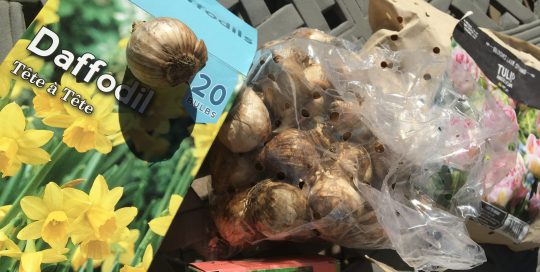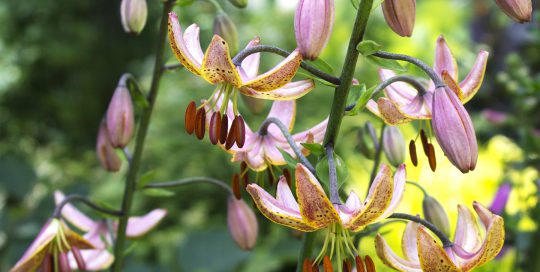Eye-catching Canna Lilies
Every year the swimming pool near my house fills its flowerbeds with canna lilies, and even if I’m not able to stop and take a dip as often as I’d like, I feel instantly transported to a tropical isle each time I pass by and see the glossy leaves and brightly colored flowers beckoning. Foliage is eye-catching in greens, browns, reds, and purples, and the bold flowers are dynamic whether they’re red, pink, yellow, or white. Cannas commonly reach 3-5 feet in height, with some even stretching to 8 feet. And despite their towering stalks, cannas rarely require staking since stems are sturdy and thick. They love the heat and full sun, so plant bulbs, or rhizomes, in a bright spot after the last frost. Mulch plants and water deeply at least once a week to keep soil moist.
Asiatic Lilies for Bees and Butterflies
Asiatic lilies, with their upright stems and trumpet-shaped flowers are true lilies, members of the genus Lilium, and not to be confused with the somewhat more commonly encountered daylilies. Flowers can be orange, yellow, red, white, or pink. The blooms are showy and often fragrant which makes them attractive to butterflies, bees – and people, too! Blooms not only look great in the flowerbed, but are fantastic when cut for arrangements. Bulbs are easy to grow and relatively carefree, as long as they’re planted in well-drained soil with 6-8 hours of sunlight every day. Asiatic lilies benefit from soil amended with organic matter, mulch, and regular watering. Taller varieties can be staked to prevent them from flopping over after a heavy rainfall. Plants typically vary in height from 2-4 feet, so for best results choose the right plant for the right place.
Mid-to-late Summer Crocosmia
Crocosmia, with its spiky foliage and gracefully arcing blooms, is a great choice for a sunny spot. Members of the iris family, crocosmia can be planted when the danger of frost has passed for mid-late summer blooms that last until fall. Stems regularly reach two feet in height. The flowers, in shades of warm reds, yellows, and oranges are mildly fragrant and great for cutting and bringing indoors. Leaves sometimes have a pleated or rippled appearance that provide a nice contrast to their flowers and makes them distinctive in the flowerbed. Since crocosmia won’t thrive in soggy conditions, be sure to plant it in well-drained, slightly acidic soil.
How to Care for These Plants in the Fall
You really can’t go wrong with any of the choices on this list. All are summer-blooming bulbs and low maintenance without sacrificing on beauty, and most can be preserved from one year to the next by digging them up in the fall and keeping them over the winter. As the weather starts to cool off, and foliage begins to yellow, gently dig up bulbs, (or corms, tubers, rhizones), shake off loose dirt, rinse, and allow them to dry completely before storing.
Discard any bulbs that are shriveled or have signs of disease and trim off the stems and foliage. Layer bulbs in containers filled with newspaper or another storage medium, making sure to give them plenty of space so there’s no overlapping. Store the containers in a cool, dry location such as a garage or unheated basement. And don’t forget to label your bulbs! In very early spring, bulbs can be planted indoors in pots to be moved outdoors when the weather warms up, or wait until soil temperatures start to climb and plant the bulbs directly in the ground for another great summer show.









